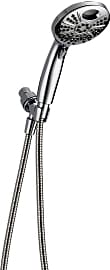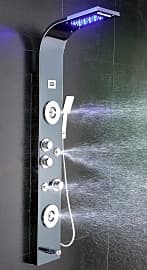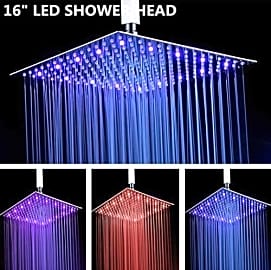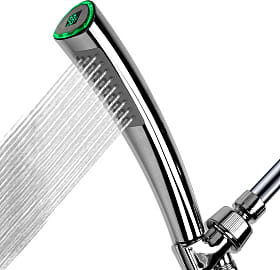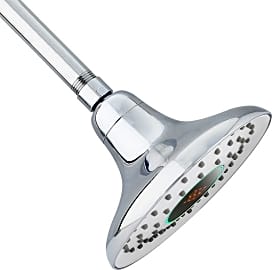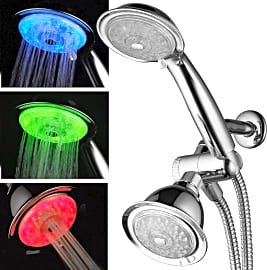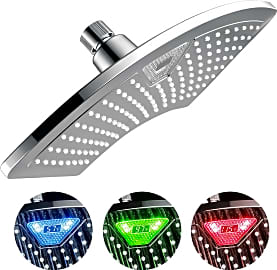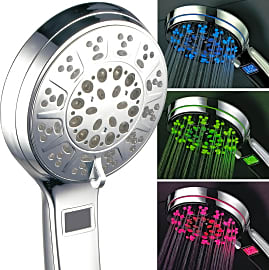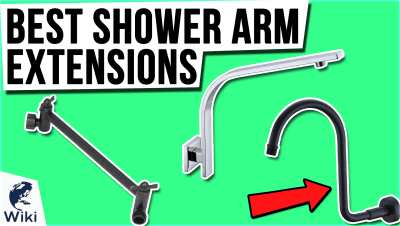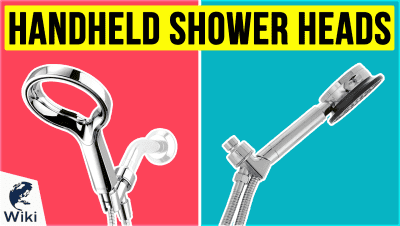The 10 Best LED Shower Heads

This wiki has been updated 44 times since it was first published in April of 2015. If you want to brighten up your bathroom and simultaneously enhance your showering experience, then installing one of these LED shower heads is a good place to start. The lights aren't just for fun and games, either — they can be used to tell you when the water is warm enough for you to get in, and help you quickly determine if it's a safe temperature to bathe your kids or pets. When users buy our independently chosen editorial picks, we may earn commissions to help fund the Wiki.
Editor's Notes
April 16, 2021:
More than just a colored accent in your showering area, these LED showerheads are usually temperature sensitive and will change color depending on how hot or cold the water is. This makes it simple to tell with just a glance if it's ready to use and can prevent injury from scolding. Additional features such as digital displays and water usage sensors make them particularly useful for families with children and the elderly.
An important consideration when choosing the most suitable one for your home is the plumbing connection. If you are replacing an old or worn-out unit then it's important to choose a showerhead that can be installed on the existing outlet. The HotelSpa 1485 is just the head and should fit on to any flexible hose. Similarly the Delta Temp2O, the Yoo.Mee Handheld, and the Power Spa Luminex all come with diverter valves and hoses, allowing them to be installed on a fixed outlet or a slide bar kit. The DreamSpa AquaFan, the WaterHawk Smart, and the DreamSpa 1482 are all designed to be used with a wall-mounted fixed outlet and can be combined with an extension arm if necessary. The Fyeer Ultra-Thin and the Cascada Showers Recessed are both ceiling-mounted options, which may appeal more to those undergoing a full bathroom renovation, as the pipework will probably need redirecting. The latter is an extra-large model that is available with a range of lighting styles and optional extras like body jets.
March 31, 2020:
During this round of updates, while most of our previous selections maintained their positions, we did remove the Hiendure Round due to availability issues, and the DeliPop Sensor 3 in order to make room. Our new additions this time around are the Fyeer Ultra-Thin FN102616S-N – a 16-inch, square rain head that can easily be installed in most common showers, even if it requires the use of an extended arm – and the Cascada Showers HDD991 – a much larger model, with a footprint of five square feet, that requires professional installation.
A few things to think about for this category:
Power Source: What’s really fascinating about most options in this category – for gear geeks like myself – is that, in spite of their integrated LED lighting, they don’t require any power source – utility, battery or otherwise. The way this is accomplished is through turbine-powered LEDS, which essentially apply the principles of hydro generation on a micro scale. This means that, as water flows through the shower head, it turns a tiny turbine inside the fixture, which in turn converts that mechanical energy into the small electrical current necessary to power its integrated LEDs. It’s a completely self-contained system.
One exception that should be noted is the Cascada Showers HDD991, which needs to be hooked up to a 120-volt supply line, accounting for part of the reason why professional installation is strongly recommended for this option.
Spray Settings: Half the luxury of a nice shower head is being able to customize your shower experience by adjusting its spray settings. While simple rain models like the DreamSpa AquaFan might only have a single spray setting, others will commonly have more. The HotelSpa 1485 features five spray settings. And, between both of its heads, the Power Spa Luminex is capable of 24 spray combinations. Consider how important this versatility is to you, and pick an option accordingly.
Bells and Whistles: Many options in this category have fun and useful extra features that go above and beyond the normal call of duty for a shower head. While the Cascada Showers HDD991 comes with an auxiliary hand-held head, the Delta 75668 Temp2O has a digital temperature display, the Ello&Allo Shower Panel features four horizontal jets, and the WaterHawk Smart monitors your water usage every shower.
Special Honors
LightInTheBox While this online retailer carries a variety of LED shower heads similar to the ones available on major websites and available in prominent box stores, what sets it apart is some of its high-end models that, while being quite pricey, incorporate features like bluetooth speakers and options for recessed mounting. lightinthebox.com
F-Series A leading brand in high-quality bathroom fixtures and fittings, Grohe supplies a range of showerheads and complete systems. Their Rainshower F-Series is offered with a choice of three different sizes of square heads and with LED lighting, optional extras include body jets and digital controllers. grohe.us
A Brief History Of Showers
Today, much of the world considers a daily shower an absolute necessity.
Showering is something that humanity has enjoyed for almost all of our existence. Initially, it meant finding a waterfall that you could stand under without killing yourself, but starting around 3100 B.C.E., the rich and powerful in Egyptian and Mesopotamian society were able to enjoy at-home showers — thanks to their servants, who poured pitchers of water over them.
The first "true" showers would be created by the ancient Greeks, who created vast aqueduct systems that allowed water to be piped into buildings. They used these to build communal showers that were used by both elite and common folk.
The Romans borrowed much of this when they established their bathhouses. After the fall of the Roman Empire, however, many early Christians believed regular bathing to be a sign of vanity. Showering for anything other than a special occasion fell out of favor, and became reserved for only the super-wealthy in society.
That all changed when the Black Plague came along, though. With people dying by the thousands, the benefits of even rudimentary hygiene were soon appreciated.
In 1767 C.E., a British stove maker named William Feetham designed a way to pipe water into the house using a hand pump. The user would fill a large vessel above their head, which would then be dumped out with the help of a pull chain.
This shower had a few major drawbacks, the first being that it was a closed system that recycled the same dirty water time and time again. It also had no way of heating the water, which is truly barbaric.
In 1810, the English Regency shower hit the scene. This was a huge shower that boasted a large basin and multiple metal pipes that drizzled water over the user's shoulders. It still recycled water, but it was the basic skeleton of the modern shower. With the advent of indoor plumbing in the 1850s, showering began to slowly catch on as an essential part of human hygiene, with the French army adopting it as a daily ritual in the 1870s.
In 1907, J.L. Mott Ironworks debuted fixtures that closely resembled those we use today, especially the shower head. Its basic design would stay the same until 1992, when conservation efforts required the use of dampeners and regulators to ensure that water was not wasted.
Today, much of the world considers a daily shower an absolute necessity.
Do You Really Need An LED Showerhead?
Let's cut to the chase. The answer is no, you don't need an LED showerhead. No one does. However, there are some sound reasons to purchase one, and the people who are most likely to benefit from them aren't those looking to recreate the club experience in the privacy of their own bathroom.
Most importantly, though, they'll make you feel like you're showering in the future — and if you stay in there long enough, you just might be.
Surprisingly enough, it's parents with small children and elderly people with limited mobility who will likely benefit the most from one of these units. Most of them use their LEDs to indicate water temperature, so you can tell at a glance whether the water is safe before you get in — or put your baby in.
That being said, the club-goer inside of you can still enjoy them. They definitely liven up your daily shower, and provide a fantastic ambiance that makes you not want to get out.
You can enjoy them without feeling guilty, however, as many of them track water flow, helping you with your conservation efforts. It's a smart — and fun — way to get the whole family involved in limiting water usage, and it definitely beats turning the water off on your family members mid-shower.
So no, you don't need one of these. But that doesn't mean that it can't be a smart purchase that can save you money down the road, whether in terms of water usage or hospital bills.
Most importantly, though, they'll make you feel like you're showering in the future — and if you stay in there long enough, you just might be.
How To Save Water (Without Taking Subpar Showers)
You already know that you need to be using less water. Unfortunately, you also already know how fantastic taking a long, hot shower can be. Luckily, there are ways to limit your usage without sacrificing the best part of your day.
The most important thing you can do is be absolutely fanatical about finding and fixing leaks. This is pure waste, as you don't even get to enjoy it — but you'll surely pay for it once that utility bill comes in the mail. Don't drag your feet on this.
Unfortunately, you also already know how fantastic taking a long, hot shower can be.
Also, while you're waiting for the water to warm up, put a bucket under the faucet to catch the cold water. You can then use it to water plants, fill pets' water bowls, or even flush the toilet.
Of course, you should also try to limit the time you're in there. Consider adding a little music to your shower, and try to finish up in the time it takes to play a song or two. Of course, if you shower to November Rain, the entire Earth will be dry and arid by the time you're done.
If you're really fanatical, you can borrow a trick from the military. Use just enough water to get your body wet, then turn it off and lather up. Then, turn it back on again and use only as much water as it takes to rinse yourself off. Fun? No. Efficient? Very.
If your daily shower is a treat you're not willing to do without, there are certainly ways you can continue to enjoy it without a guilty conscience. It just takes a little vigilance — and maybe hearing Dad's voice in your head reminding you that water isn't free, you know.


